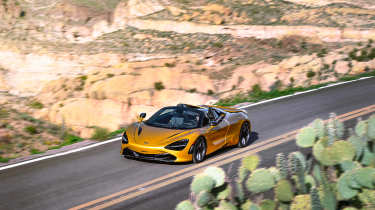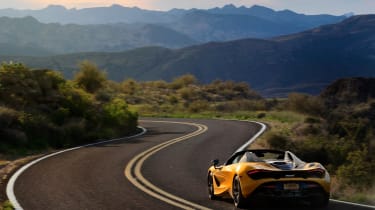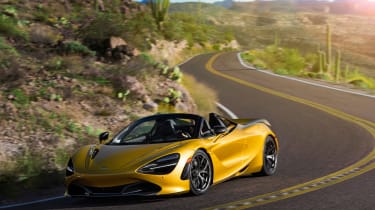McLaren 720S Spider review - a drop-top supercar without compromise?
Top down motoring to the list only increases the 720S’ appeal, however the compromises felt dynamically still makes the coupe our choice
If you’re hoping for a surprise in Mclaren’s relentless product plan, this isn’t the moment for it. The open top version of the firm’s Super Series supercar, the 720S, was always going to arrive at some point after the introduction of the coupe in 2017. We’re already massive fans of that car - the ability to remove the roof, with no expected compromises to the car’s dynamics, could make this the pick of the range.
Engine, transmission, 0-60 time
There are no changes to the running gear for the Spider variant, but then the words ‘more performance please’ have surely never been uttered in the same breath as ‘720S’. So it’s the same 710bhp 4-litre twin turbo V8, with the full 568lb ft of torque available from 5,500-6,500rpm. One day, possibly not far from now, and in an all-electric future, we’ll probably look back on the McLaren V8 as representing the high water mark of internal combustion supercar engines. Having said that, we’ll also still probably be moaning about its ‘industrial’ soundtrack...
> Click here for our review of the Ferrar 488 Spider
As ever, the V8 is hooked up to the superb seven-speed twin-clutch gearbox, with its virtually instantaneous shifts. Predictably, the efficiency of this combined with the power of the V8 and a relatively light structure (down to 1,332kg ‘dry’) means the Spider posts some blistering acceleration times. The 0-60mph time is identical to the coupe at 2.8-seconds, with the Spider losing just a tenth by 124mph at 7.9-seconds. Essentially, you’re really not going to feel the difference; in fact, with the sound and commotion of the slipstream it’s probably going to feel a good deal faster. Top speed is a coupe-matching 212mph with the roof closed, and ‘just’ 202mph with it open.
Technical highlights
Carbon fibre MonoCell, check. Frenzied V8, check. Unique exterior design that channels the airflow in all sorts of clever ways, check. Mclaren’s Proactive Chassis Control II, check. Clearly, what’s new about the Spider is that roof. Building on the firm’s experience with the retractable hard top in the 650S (and its Sports Series cars for that matter), this is another clever and compact piece of engineering. It takes just 11 seconds for the carbon fibre roof panel to both fully retract and to raise back into the closed position, some six seconds quicker than the old 650S. It can also now operate at speeds of up to 31mph (as opposed to the 18.5mph of before), meaning you don’t have to embarrassingly stop the traffic when that rain shower begins.
More reviews
> Click here for our review of the McLaren 720S Coupe
One of the key aims of the 720S project has always been its useability, and therefore it’s no surprise the company has worked hard on maintaining the type’s trademark visibility even with the compromise of a folding roof. The rear buttresses are therefore glazed, and the over-the-shoulder visibility is extraordinarily good for a mid-engined supercar. An electrically-operated window between the buttresses acts as a windbreak, but also means the rear of the cabin can be open to the elements even with the roof in the raised position. To achieve all this McLaren has modified the Monocage II tub, christening it II-S. The central overhead spar is omitted, and the rear of the tub modified with exposed carbon fibre roll over protective supports. An electrochromic roof panel is an option, switching the glass between transparent and tinted at the touch of a button.
What’s it like to drive?
Love it or loathe it for it, the 720S makes extreme supercar performance almost ludicrously accessible. It is surely by some margin the easiest of all the low slung, mid-engined, 200mph+ machines to drive on a daily basis, asking for virtually nothing in its sleepiest driving mode to pad around in surprisingly undemanding comfort. Then again, hit the Active panel for individual control of Powertrain and ‘Handling’ and the Spider absolutely explodes into life, slamming forward with the sort of latent energy that feels self-consciously illicit when accessed on the public road. Naturally, the sensations are all magnified by the rush of air around the head with the roof lowered, with buffeting manageable if still notable. The V8 hardly plays a memorable tune, but its raw machinations are that much more authentic sounding when there’s nothing between ear and exhaust pipe. You also get a clearer sense of the turbos sighing, whooshing and gasping as they deal with the boost, and the first time the exhaust emits a ‘crack’ on a downshift you’ll think someone is firing live rounds over the cockpit...
From its beautifully-judged driving position, and spartan yet focused cockpit, to the natural responses of its hydraulically assisted steering and its hyper agility, there are a great many reasons why we love the 720S. So far, so good, then, but there’s one key assumption with the Spider, and that’s thanks to the carbon fibre rub at its core, the only penalty from lopping off the coupe’s roof will be the extra 49kg that also slightly raises the car’s centre of gravity. In theory, the numbers are small enough that only a highly skilled driver, on the limit, on a circuit, and comparing variants back-to-back, might potentially be able to tell the difference. Maybe.
However, while Arizona’s straight and featureless roads made for an uninspiring test route, what corners and poorer road surfaces we did encounter seemed to generate the sort of wobbles usually associated with the more traditionally-constructed Ferrari 488 Spider. A vibration through the header rail that blurred the rear view mirror and a tremor felt through the steering rack that went beyond mere kickback suggest rigidity has been compromised - and yet McLaren are adamant that’s impossible with the Monocage II-S. True, these were very early build cars, and this was hardly a conclusive drive, but we didn’t imagine it, and we weren’t the only ones to notice it...
Price and rivals
While the ‘standard’ Spider costs £237,000, the Performance and Luxury trim levels are £246,990 and with the inevitable personalisation options, the price easily gets close to £300,000. Extravagant? Consider that some cars on the launch had over £30,000 of exterior carbon fibre embellishment alone...but then this is the market of cars such as this, and Ferrari’s 488 Spider, and the forthcoming Lamborghini Huracan Evo Spyder.







